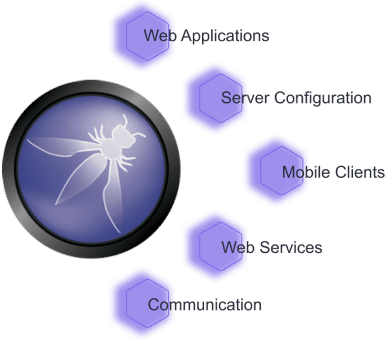ASVS certification
FAQ
OWASP ASVS (Application Security Verification Standard) is a comprehensive set of requirements and guidelines for verifying web application security. Maintained by the Open Web Application Security Project (OWASP), it's designed for use by developers, architects, testers, and security professionals to ensure applications are secure against common vulnerabilities.
Key features of OWASP ASVS include:
- Three levels of verification, with increasing requirements and testing depth
- Coverage of various security areas, including authentication, session management, access control, input validation, error handling, and cryptography
- Detailed requirements, recommendations, testing procedures, and remediation guidance for each area
The verification levels are tailored to the application's sensitivity and associated risks.
It's important to note that OWASP ASVS is not a certification program, but rather a set of guidelines for verifying web application security. However, you can use ASVS to guide your security testing efforts and improve your web applications' security.
For those interested in application security certification, alternatives include:
- Certified Application Security Engineer (CASE) by IACSIT
- Certified Secure Software Lifecycle Professional (CSSLP) by (ISC)²
To prepare for these certifications:
- Take relevant courses and training programs
- Practice implementing security controls in web applications
- Gain practical experience through security assessments
- Work with development teams to implement secure coding practices
OWASP ASVS compliance involves verifying that a web application meets the requirements and guidelines outlined in the ASVS. This process helps organizations enhance their web applications' security and reduce vulnerability risks.
Compliance assessment includes:
- Thorough evaluation of security controls (authentication, access control, input validation, etc.)
- Selection of appropriate verification level based on application sensitivity and risk
- Identification and remediation of security gaps
- Implementation of additional or improved security controls
- Code updates to address identified vulnerabilities
Assessments can be conducted by internal security teams or third-party professionals.
Implementing OWASP ASVS guidelines in web application development and testing offers several benefits:
- Improved Security: Reduces vulnerability risks and protects against common web application attacks
- Standardization: Provides consistent guidelines for security verification across teams and organizations
- Compliance: Helps demonstrate adherence to security standards and regulations (e.g., PCI DSS, GDPR)
- Cost-Effectiveness: Early vulnerability identification saves time and money on post-deployment fixes
- Enhanced Reputation: Secure applications build user trust and potentially increase customer loyalty
The OWASP ASVS is an open-source project available for free download from the OWASP website. There is no cost associated with accessing or using the ASVS guidelines.
However, potential costs may arise from:
- Third-party security assessor services for ASVS compliance assessment
- Commercial security tools and services incorporating ASVS guidelines
The cost of these services varies based on factors such as:
- Web application complexity
- ASVS compliance level being evaluated
- Security assessor's experience and expertise
- Specific features included in commercial tools or services
Organizations should consider these potential costs when planning to implement OWASP ASVS in their security processes.
An OWASP ASVS audit is an assessment of a web application's security posture against the ASVS guidelines. Typically conducted by a third-party security assessor, it aims to identify potential security vulnerabilities in the application.
The audit process involves:
- Detailed review of the application's architecture, code, and configuration settings
- Security tests to evaluate the effectiveness of security controls
- Techniques such as vulnerability scanning and penetration testing to simulate attacks
The audit evaluates compliance with ASVS guidelines across various security areas, including authentication, access control, input validation, and cryptography.
Output: A detailed report typically includes:
- Testing methodology overview
- Summary of findings
- Recommendations for improving security posture
- Summary of ASVS compliance, including verification level achieved
Conducting OWASP ASVS verification involves these steps:
- Determine Verification Level: Choose the appropriate level (1-3) based on application sensitivity and associated risks.
- Evaluate Security Controls: Assess the application's security controls against ASVS guidelines.
- Conduct Testing: Verify the effectiveness of security controls through vulnerability scanning, penetration testing, etc.
- Identify Gaps and Deficiencies: Pinpoint security control gaps and assess associated risks.
- Remediate Vulnerabilities: Develop and implement a plan to address identified vulnerabilities.
- Re-Test: Verify successful remediation of identified vulnerabilities.
- Document Results: Record the verification process, identified vulnerabilities, and remediation steps taken.
OWASP ASVS certification is important for several reasons:
- Demonstrates Compliance: Shows commitment to application security and industry best practices.
- Improves Security Posture: Provides comprehensive security controls and testing requirements.
- Mitigates Risk: Helps reduce the likelihood of security incidents, data breaches, and system downtime.
- Enhances Customer Trust: Demonstrates a proactive approach to protecting sensitive data.
The OWASP ASVS certification process duration varies based on factors like certification level, application complexity, and organizational readiness. It typically takes several weeks to several months and involves these steps:
- Preparation: Review guidelines, conduct self-assessment, and identify certification level.
- Assessment: A third-party security assessor evaluates the application against ASVS guidelines.
- Remediation: Address identified vulnerabilities and implement required security controls.
- Re-Assessment: Verify remediation and ASVS requirement compliance.
- Certification: Receive certification at the appropriate ASVS level.
Note: The time frame can vary significantly depending on the organization's initial security posture and resources dedicated to the certification process.


